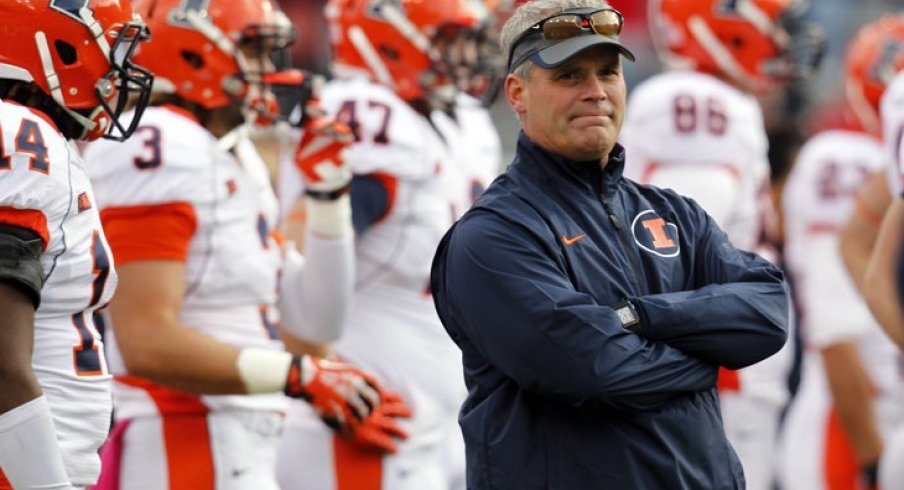Wes Lunt was supposed to be the breakout star of the Fighting Illini.
The Oklahoma State transfer and former blue chip prospect gained eligibility this fall after making his way north to Champaign, taking over an offense in dire need of direction. After sitting out the 2013 season, the Illinois native was the clear starter heading into 2014, looking to show why he had been so highly recruited three years ago.
In five games this season, the sophomore lived up to the hype, throwing for over 1,300 yards, 13 touchdowns, and only three interceptions. But once again, injuries have slowed down Lunt, as a broken leg suffered against Purdue has kept him out of action since early October.
In that span, the Illinois offense has had trouble keeping that momentum through the air as backup Reilly O'Toole struggled when asked to run the offense designed for Lunt. At the same time, the Illini defense was giving up massive gains on the ground, as the Nebraska, Wisconsin, and Purdue (yes, Purdue) all racked up huge rushing totals.
The Illini have run a spread offense since Beckman's arrival in Champagne, but often attacking teams much more through the air. Quarterback, Nathan Scheelhaase threw for over 3,200 yards and 21 touchdowns last season, compared with a running game that only averaged 139 yards-per-game.
But over the last two weeks, the Illinois offense has looked like a completely different unit, running multiple types of zone-read options. The Illini have racked up 276 yards against Wisconsin and Minnesota, a major improvement for a team that had averaged only 96 rushing yards-per-game to that point.
In the process, the Illini were able to pull off a big home victory against the then 6-1 Golden Gophers last weekend, giving the program a much needed spark, and potentially saving head coach Tim Beckman's job. Beckman, who has deep Ohio roots, seemed to have channeled two of his former bosses in the win, using a spread-to-run offense like Urban Meyer, while winning the field position battle like Jim Tressel.
When asked about both in this week's Big Ten teleconference, Beckman was very complimentary of the pair. When asked what he learned from Tressel, he noted,
"We don't have enough time I don't believe. Jim Tressel has meant the world to me"
and of Meyer,
"I consider Urban a friend. ... There's a lot of things that we do in this program that have an Urban flavor."
With a big matchup with Michigan State on the horizon, do Beckman and the Illini have what it takes to catch the Buckeyes looking ahead, dashing their potential conference title hopes in the process?
Offense
Perhaps no concept encompasses the change in Illinois' offensive philosophy more than the triple option. Often lining up with running backs Josh Ferguson (#6) and Donovonn Young (#5) on either side of him in the shotgun, or by bringing a slot receiver in motion, O'Toole has shown a good ability to make the correct decision on when give or keep the ball.
Much like the Buckeyes, the Illini rely heavily on the tight zone blocking scheme to get a strong push inside. However, they'll often leave a defensive end unblocked, using the option to effectively take him out of the play.
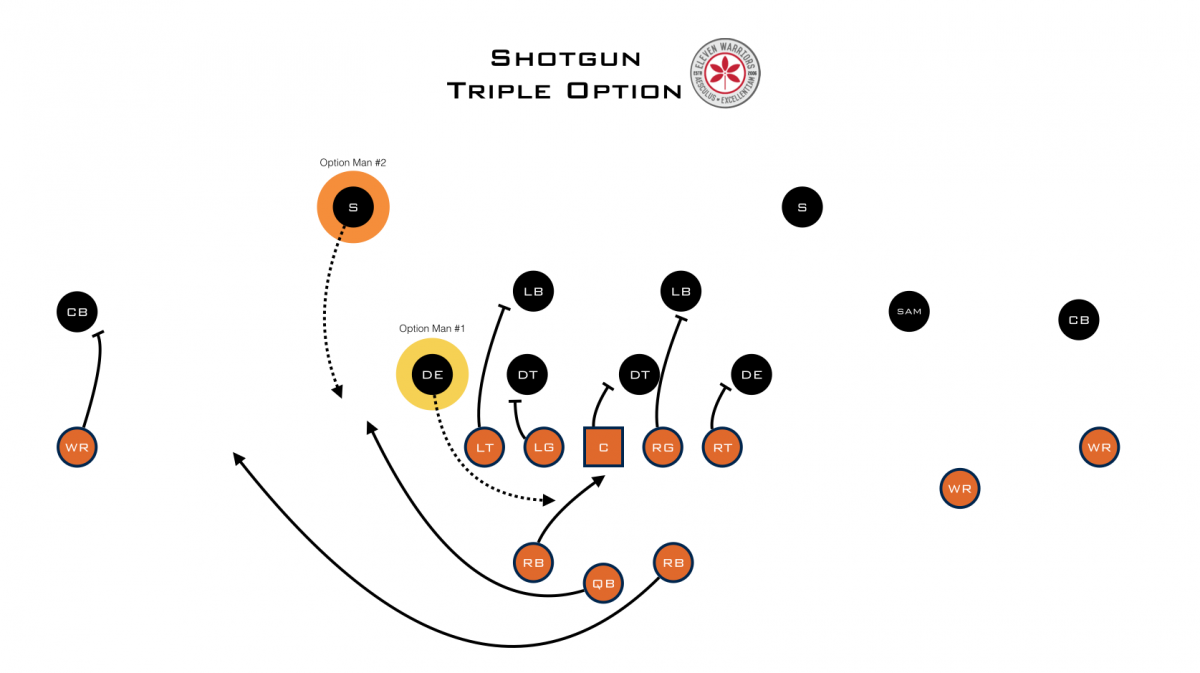
If the end takes the bait and crashes down on the running back inside, then O'Toole simply fakes the handoff and runs outside. From there, the Illini QB looks for the first "alley" defender, usually a safety or linebacker responsible for the area between the offensive line and the receiver. If this defender goes straight for O'Toole, he has the second running back who has looped around behind him to take a pitch to the outside.
After seeing the success Navy had running the triple option against the Buckeyes in week one when they racked up 370 rushingyards, there is little question the Illini will look to find the same open spots in the Ohio State defense. Even though it's done from a very different set of formations and personnel, the Naval Academy's flexbone-option game is built on the tight zone inside, with the QB and pitch man attacking the same alleys.
Once they establish the tight zone and triple option, Illinois will begin running a number of different option plays to keep defenses from over-playing any one of them.
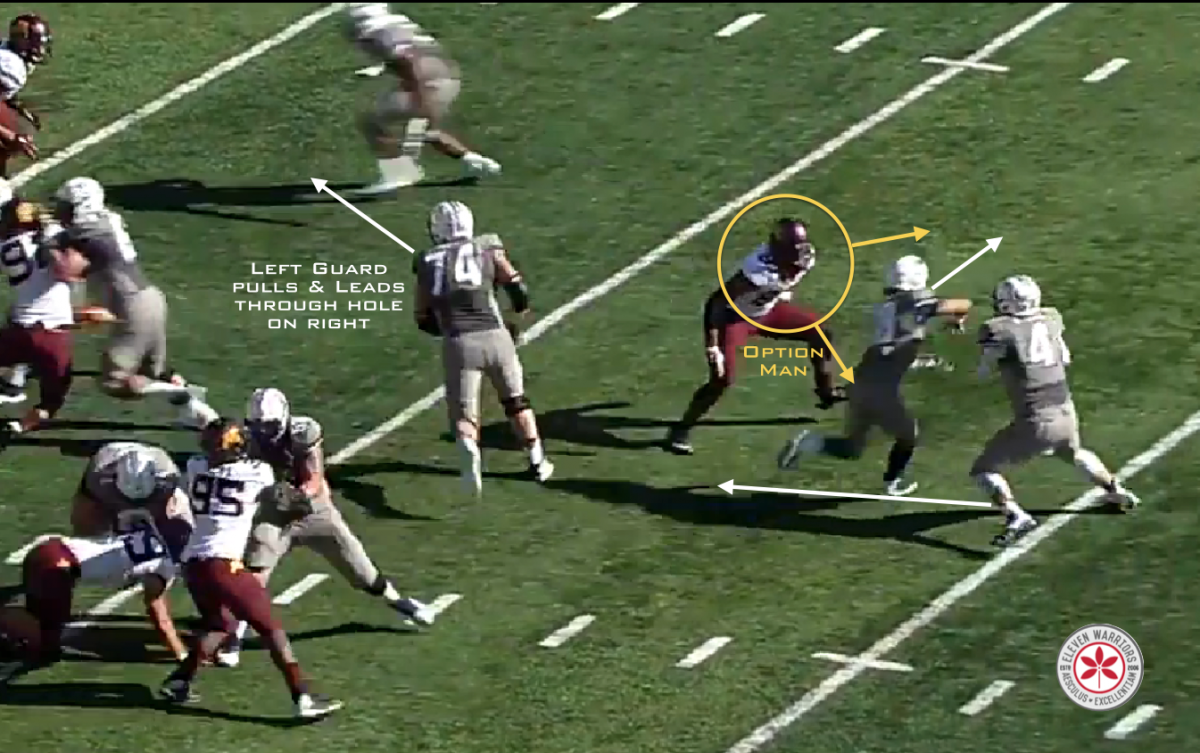
One of their favorites is the Inverted Veer (aka Power-Read) with a motioned receiver, giving the quarterback the option of handing the ball to him on an outside jet sweep, or keeping it himself and running inside behind a pulling guard. O'Toole has shown to be a capable inside runner, picking up 59 yards on the ground last weekend, most of which came between the tackles.
Ferguson and Young are quick and most dangerous on the outside, so the Illinois coaches have found even more ways to get them the ball in space. Knowing the defense is keying in on O'Toole and any other backfield action, the Illini dial up a number of screens and swing passes, sneaking the running backs out quickly and giving the quarterback an easy throw.
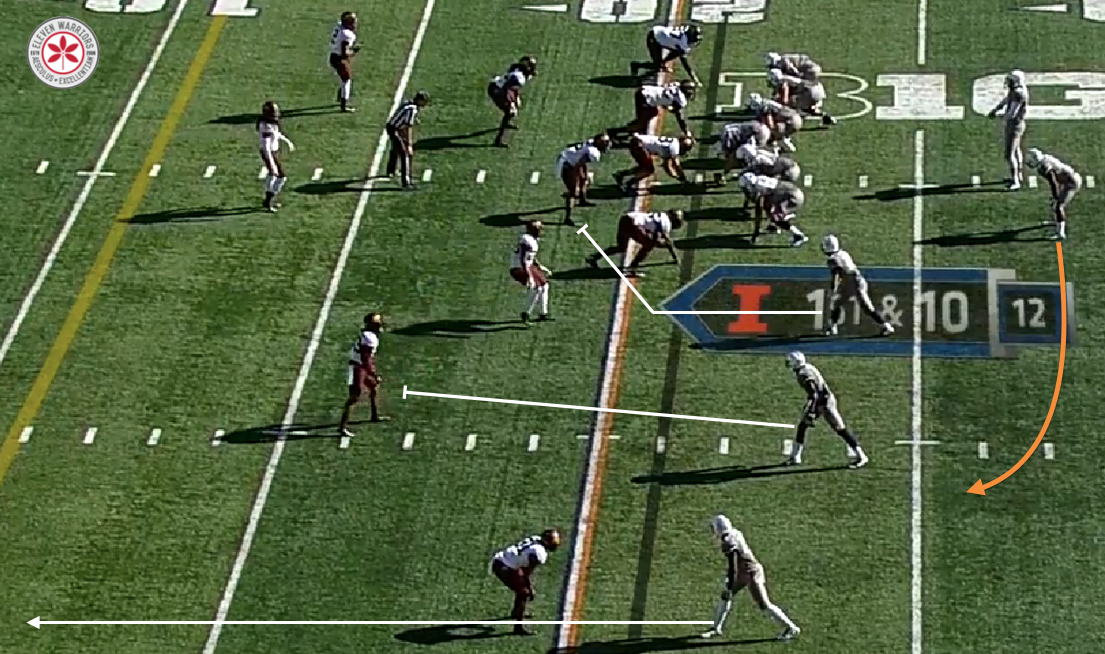
Ferguson, especially, has shown the ability to beat tacklers one-on-one when in the open field, so recognizing these situations and keeping disciplined angles will be critical for the Buckeyes to limit big plays.
Although he has a strong arm, O'Toole hasn't shown much consistency when throwing downfield. His favorite receiver is Mike Dudek (#18), an undersized freshman from the Chicago suburbs who wasn't heavily recruited has been the lone bright spot in the Illini passing game since Lunt went down. Dudek is an excellent route runner already, with good quickness and a good understanding of how to find the space in between zone defenders.
To make life easy for O'Toole, the Illini like to call a number of short, quick throws that allow Dudek to find open seams in the defense. In this way, the Illini offense looks much like an Air Raid team, calling quick concepts like All-Curls, Four Verticals, and Mesh.
Each of these throws should be made after making just one or two reads, often usually all in one part of the field. Luckily for the Buckeyes, these schemes are all fairly basic, and have been run by multiple teams they've faced thus far. Very few adjustments should have to be made from a schematic standpoint for the Ohio State defense, they simply need to execute their base concepts and not give up any big plays.
One big reason they won't have to do to much on the back end is the disparity in talent between the big men up front. The 2014 Illini offensive line has been one of the worst in the country at protecting the quarterback, ranking 115th out of 128 teams with 25 sacks surrendered so far. After watching Joey Bosa, Michael Bennett, and the rest of the Buckeye defensive line dominate their counterparts from Penn State, the Illini offensive line must know that they must play mistake-free in order to have any shot at putting up points.
Defense
The Illini offense needs to worry so much about putting up points because their teammates on defense has a bad tendency of giving up quite a few of them. Through seven games, Beckman's defense has surrendered 275 points, the highest total in the conference.
The core of their problems has been their inability to stop the run. Regardless of the scheme, the Illinois defensive line really struggles to get off the blocks of bigger, talented offensive lines. In their five games against teams from the "Power 5" conferences, they've given up at least four yards-per-carry. In addition, Wisconsin and Nebraska each put up over 400 yards on the ground against the not-so-Fighting Illini defense.
Both teams ran the same, basic outside zone scheme over and over, getting to their linebackers and creating gaping lanes for their running backs. As talented as players like Melvin Gordon and Ameer Abdullah may be, their job was made very easy with massive holes to run through.
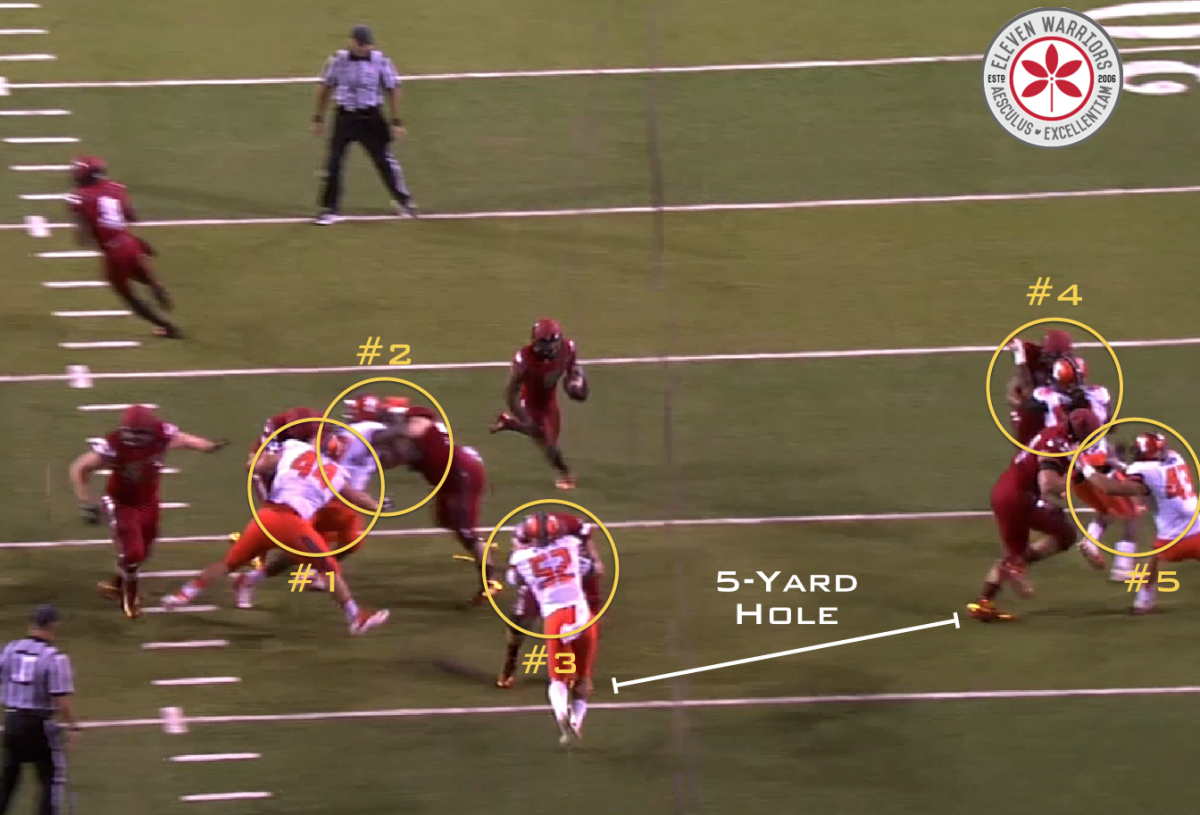
With the defensive line struggling to get off blocks, opposing offensive linemen are able to get to the second level and block Illinois' linebackers. Knowing the linebackers are getting attacked, the Illini safeties have had to get very involved in stopping the run.
Instead of running the Cover 4 scheme they tried to run in earlier games against lesser competition, the Illini have had to commit at least one or two safeties in the box, forcing them to play with only one-high safety.
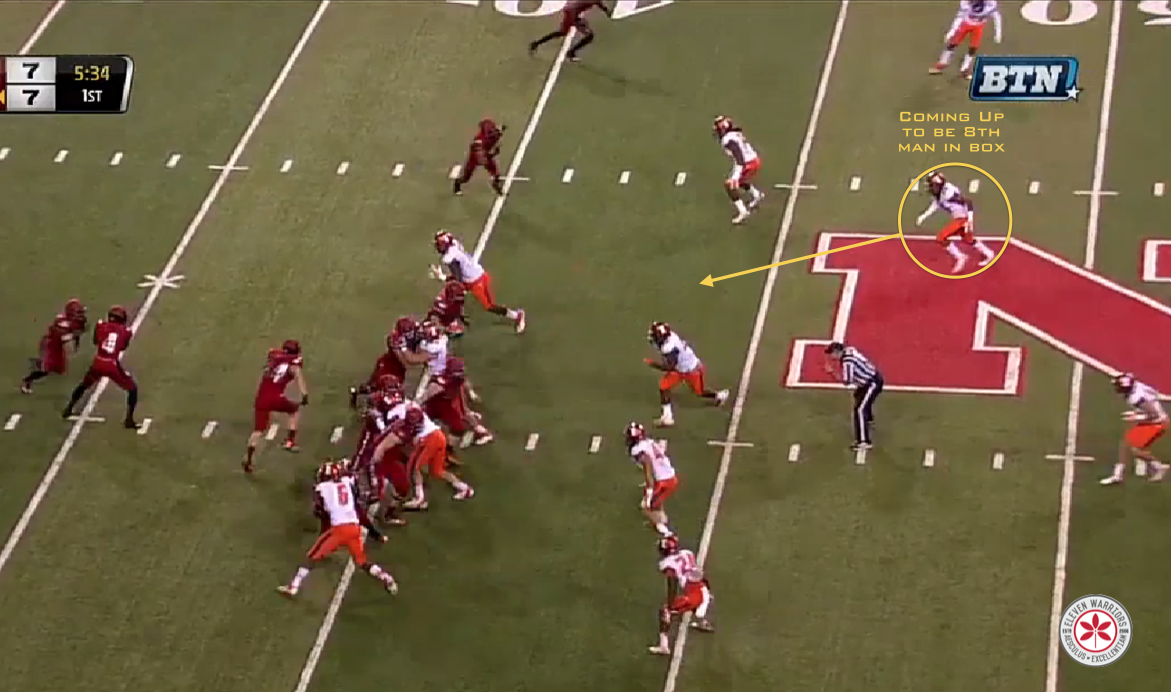
With only one safety in the middle of the field, the Illini secondary can really only play Cover 1 or Cover 3. Regardless of which is called, if opponents send receivers deep downfield, the cornerbacks are effectively playing man-to-man coverage as they're the only defender there to make a play.
Opponents have often taken advantage, looking to connect on deep balls against this single coverage. The Illini have given up six pass plays of 50 yards or more, the fourth-worst total in the country.
Cornerback V'Angelo Bentley (#2) of Glenville High School in Cleveland has shown a good ability to jam receivers without getting beat off the line of scrimmage, and although he offers the best challenge to the OSU receiving corps, but he can only cover one man at a time.
After throwing the ball for a season-low 74 yards against Penn State, this could be a great opportunity for the Ohio State passing game to get back on track. Confidence, both from the players executing the plays and the coaches calling them, is a major aspect of any aerial attack, and the Buckeyes assuredly will look to regain theirs before taking on Michigan State the following week.
There is no reason to believe the Buckeyes will not attack this Illini defense, looking to rebound from their subpar showing the week prior. Judging by what we've seen from them so far, the Fighting Illini may be in for a long night.
